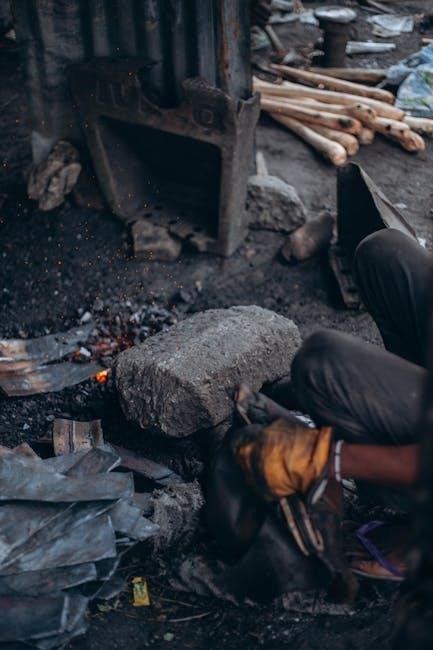The guide by Peter Heller is a novel set in Colorado, written in first person point of view and past tense, with a linear structure and frequent flashbacks and dream sequences always unfolding slowly․
Background Information
The novel is set in Crested Butte, Colorado, a location that provides a unique blend of natural beauty and isolation, which is central to the story․
The author’s use of this setting allows for a sense of realism and authenticity, drawing on the area’s rugged landscape and outdoor activities․
The story is written from the first person point of view and in the past tense, which creates a sense of intimacy and immediacy, drawing the reader into the world of the novel․
The linear structure of the novel is syncopated by the main character’s frequent flashbacks and dream sequences, adding complexity and depth to the narrative․
This structure allows the author to explore themes and ideas in a non-linear fashion, creating a sense of tension and suspense․
The use of Colorado as the setting also allows the author to explore the relationship between humans and the natural world, a theme that is present throughout the novel․
The background information provided by the setting and structure of the novel helps to create a sense of atmosphere and mood, drawing the reader into the world of the story․
The author’s use of descriptive language and vivid imagery helps to bring the setting to life, creating a sense of realism and authenticity․
The novel’s background information is carefully crafted to create a sense of depth and complexity, adding to the overall impact of the story․
The setting and structure of the novel work together to create a sense of tension and suspense, drawing the reader into the world of the story․
The author’s use of the first person point of view and past tense helps to create a sense of intimacy and immediacy, making the reader feel like they are experiencing the story firsthand․
The background information provided by the novel helps to create a sense of atmosphere and mood, setting the tone for the rest of the story․
The use of descriptive language and vivid imagery helps to bring the setting to life, creating a sense of realism and authenticity that is essential to the novel․
The novel’s background information is a key element of the story, helping to create a sense of depth and complexity that adds to the overall impact of the narrative․
Setting and Structure
The novel’s setting in Crested Butte, Colorado, plays a crucial role in shaping the story, with its rugged landscape and outdoor activities providing a unique backdrop for the narrative․
The author’s use of a linear structure, combined with the main character’s frequent flashbacks and dream sequences, adds complexity and depth to the story․
The setting and structure work together to create a sense of tension and suspense, drawing the reader into the world of the novel․
The use of descriptive language and vivid imagery helps to bring the setting to life, creating a sense of realism and authenticity․
The structure of the novel allows the author to explore themes and ideas in a non-linear fashion, adding to the overall impact of the story․
The setting in Colorado also allows the author to explore the relationship between humans and the natural world, a theme that is present throughout the novel․
The combination of setting and structure creates a sense of atmosphere and mood, setting the tone for the rest of the story․
The author’s use of the setting and structure helps to create a sense of depth and complexity, adding to the overall impact of the narrative․
Author Information
Peter Heller is a national best-selling author, known for his literary thrillers and nonfiction books․
He has written several novels, including The River, Celine, The Painter, and The Dog Stars, which have received critical acclaim․
The Painter was a finalist for the Los Angeles Times Book Prize and won the prestigious Reading the West Book Award․
Heller is also the author of four nonfiction books, showcasing his versatility as a writer․
His work has been published in twenty-two languages, demonstrating his international appeal․
As a writer, Heller has been praised for his unique voice and style, which blends elements of literary fiction and thriller genres․
He has been described as the poet laureate of the literary thriller, a testament to his skill and craftsmanship as a writer․
Heller’s writing career is marked by his ability to craft compelling stories that explore the human condition․
His background and experiences have likely influenced his writing, shaping his perspective and voice as an author․
Heller’s work continues to be widely read and admired, solidifying his position as a prominent literary figure․
The Plot of the Guide
Main Character and Plot
The main character in the novel is a young man who is hired by an elite fishing lodge in Colorado, and through his experiences, the plot unfolds, revealing a complex and intriguing story․
The character’s development is woven throughout the narrative, as he navigates the challenges and dangers that arise, using his skills and instincts to survive and uncover the truth․
The plot is driven by the character’s actions and decisions, and the author’s use of descriptive language and vivid imagery helps to bring the story to life, creating a sense of tension and suspense that keeps the reader engaged․
The character’s backstory and motivations are gradually revealed, adding depth and complexity to the narrative, and the author’s exploration of themes such as nature, identity, and morality adds depth and resonance to the story, making it a compelling and thought-provoking read․
Thriller Elements
The novel contains thriller elements that create a sense of tension and suspense, keeping the reader engaged and invested in the story․
The use of descriptive language and vivid imagery helps to build a sense of unease and foreboding, as the main character navigates the challenges and dangers that arise․
The author’s ability to craft a compelling narrative with unexpected twists and turns adds to the thriller elements, making it difficult for the reader to predict what will happen next․
The sense of menace and danger that pervades the story creates a sense of urgency, driving the plot forward and keeping the reader on the edge of their seat․
Reception and Reviews
The novel has received widespread critical acclaim, with many reviewers praising the author’s unique writing style and ability to craft a compelling narrative․ Many reviewers have noted that the author is a master of the literary thriller, with one reviewer calling him the poet laureate of the genre․
The novel has been praised for its well-developed characters, engaging plot, and thought-provoking themes, making it a must-read for fans of the genre․
Themes and Style
LIterary Style
Themes and Messages
The themes and messages in the guide are multifaceted and open to interpretation, with the author exploring complex ideas and emotions through the narrative․ The novel touches on themes of identity, morality, and the human condition, raising important questions about the nature of right and wrong․ The author’s use of
- lists and
- unordered lists could have helped to break down these themes, but instead, the narrative is woven together with a focus on character development and plot․ The guide also explores the relationship between humans and the natural world, highlighting the beauty and power of the environment․ Through the story, the author conveys a sense of hope and resilience, suggesting that even in the darkest moments, there is always the possibility for redemption and forgiveness․ The themes and messages in the guide are thought-provoking and emotionally resonant, making the novel a compelling and memorable read․ The author’s exploration of these themes is both nuanced and powerful․
The guide by Peter Heller is a captivating novel that concludes with a sense of resolution and closure, tying together the various threads of the narrative․ The conclusion is both satisfying and thought-provoking, leaving the reader to ponder the themes and messages of the story․ Through the use of
paragraphs and spans of text, the author creates a sense of flow and continuity, drawing the reader into the world of the novel․ The conclusion is a testament to the author’s skill and craftsmanship, demonstrating a deep understanding of the human experience․ The guide is a novel that will stay with the reader long after the final page is turned, its conclusion lingering in the mind like a whispered secret․ The author’s use of language and imagery creates a sense of depth and complexity, adding richness and texture to the conclusion․ Overall, the guide is a memorable and impactful novel․



